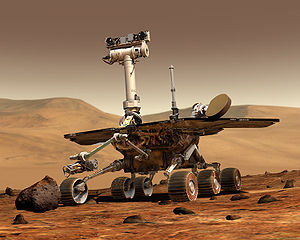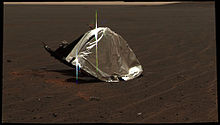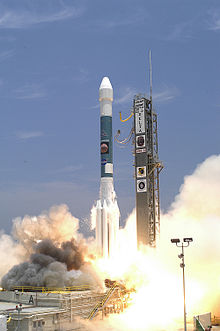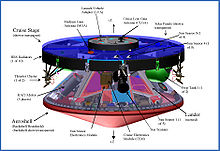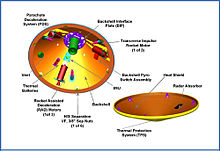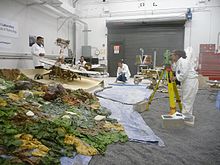- Mars Exploration Rover
-
NASA's Mars Exploration Rover Mission (MER) is an ongoing robotic space mission involving two rovers, Spirit and Opportunity, exploring the planet Mars. It began in 2003 with the sending of the two rovers—MER-A Spirit and MER-B Opportunity—to explore the Martian surface and geology.
The mission's scientific objective was to search for and characterize a wide range of rocks and soils that hold clues to past water activity on Mars. The mission is part of NASA's Mars Exploration Program, which includes three previous successful landers: the two Viking program landers in 1976 and Mars Pathfinder probe in 1997.[1]
The total cost of building, launching, landing and operating the rovers on the surface for the initial 90-Martian-day (sol) primary mission was US$820 million.[2] Since the rovers have continued to function beyond their initial 90 sol primary mission, they have each received five mission extensions. The fifth mission extension was granted in October 2007, and runs to the end of 2009.[2][3] The total cost of the first four mission extensions was $104 million, and the fifth mission extension is expected to cost at least $20 million.[2]
In July 2007, during the fourth mission extension, Martian dust storms blocked sunlight to the rovers and threatened the ability of the craft to gather energy through their solar panels, causing engineers to fear that one or both of them might be permanently disabled. However, the dust storms lifted, allowing them to resume operations.[4]
On May 1, 2009, during its fifth mission extension, Spirit became stuck in soft soil on Mars.[5] After nearly nine months of attempts to get the rover back on track, including using test rovers on Earth, NASA announced on January 26, 2010 that Spirit was being retasked as a stationary science platform. This mode would enable Spirit to assist scientists in ways that a mobile platform could not, such as detecting "wobbles" in the planet's rotation that would indicate a liquid core.[6] Jet Propulsion Laboratory (JPL) lost contact with Spirit after last hearing from the rover on March 22, 2010 and continued attempts to regain communications until May 25, 2011 bringing the elapsed mission time to 6 years 2 months 19 days or over 25 times the original planned mission duration.[7]
In recognition of the vast amount of scientific information amassed by both rovers, two asteroids have been named in their honor: 37452 Spirit and 39382 Opportunity. The mission is managed for NASA by the Jet Propulsion Laboratory, which designed, built, and is operating the rovers.
Contents
Objectives
The scientific objectives of the Mars Exploration Rover mission are to:[8]
- Search for and characterize a variety of rocks and soils that hold clues to past water activity. In particular, samples sought include those that have minerals deposited by water-related processes such as precipitation, evaporation, sedimentary cementation, or hydrothermal activity.
- Determine the distribution and composition of minerals, rocks, and soils surrounding the landing sites.
- Determine what geologic processes have shaped the local terrain and influenced the chemistry. Such processes could include water or wind erosion, sedimentation, hydrothermal mechanisms, volcanism, and cratering.
- Perform calibration and validation of surface observations made by Mars Reconnaissance Orbiter instruments. This will help determine the accuracy and effectiveness of various instruments that survey Martian geology from orbit.
- Search for iron-containing minerals, and to identify and quantify relative amounts of specific mineral types that contain water or were formed in water, such as iron-bearing carbonates.
- Characterize the mineralogy and textures of rocks and soils to determine the processes that created them.
- Search for geological clues to the environmental conditions that existed when liquid water was present.
- Assess whether those environments were conducive to life.
During the next two decades, NASA will conduct several missions to address whether life ever existed on Mars. The search begins with determining whether the Martian environment was ever suitable for life. Life, as humans understand it, requires water, hence the history of water on Mars is critical to finding out if the Martian environment was ever conducive to life. Although the Mars Exploration Rovers do not have the ability to detect life directly, they offer important information on the habitability of the environment in the planet's history
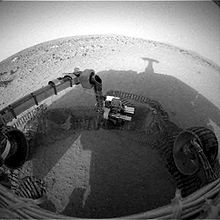 NASA's Mars Exploration Rover Spirit casts a shadow over the trench that the rover is examining with tools on its robotic arm. Spirit took this image with its front hazard-avoidance camera on February 21, 2004, during the rover's 48th martian day, or sol 48.
NASA's Mars Exploration Rover Spirit casts a shadow over the trench that the rover is examining with tools on its robotic arm. Spirit took this image with its front hazard-avoidance camera on February 21, 2004, during the rover's 48th martian day, or sol 48.
History
The probes were launched June and July 2003 and landed January 2004 in widely separated equatorial places on Mars.
On January 21, 2004, the Deep Space Network lost contact with Spirit, for reasons originally thought to be related to a thunderstorm over Australia. The rover transmitted a message with no data, but later that day missed another communications session with the Mars Global Surveyor. The next day, JPL received a beep from the rover, indicating that it was in fault mode. On January 23, the flight team succeeded in making the rover send. The fault was believed to have been caused by an error in the rover's flash memory subsystem. The rover did not perform any scientific activities for ten days, while engineers updated its software and ran tests. The problem was corrected by reformatting Spirit's flash memory and using a software patch to avoid memory overload; Opportunity was also upgraded with the patch as a precaution. Spirit returned to full scientific operations by February 5.
On March 23, 2004, a news conference was held announcing "major discoveries" of evidence of past liquid water on the Martian surface. A delegation of scientists showed pictures and data revealing a stratified pattern and cross bedding in the rocks of the outcrop inside a crater in Meridiani Planum, landing site of MER-B, Opportunity. This suggested that water once flowed in the region. The irregular distribution of chlorine and bromine also suggests that the place was once the shoreline of a salty sea, now evaporated.
On April 8, 2004, NASA announced that it was extending the mission life of the rovers from three to eight months. It immediately provided additional funding of US $15 million through September, and $2.8 million per month for continuing operations. Later that month, Opportunity arrived at Endurance crater, taking about five days to drive the 200 meters. NASA announced on September 22 that it was extending the mission life of the rovers for another six months. Opportunity was to leave Endurance crater, visit its discarded heat shield, and proceed to Victoria crater. Spirit was to attempt to climb to the top of the Columbia Hills.
With the two rovers still functioning well, NASA later announced another 18 month extension of the mission to September 2006. Opportunity was to visit the "Etched Terrain" and Spirit was to climb a rocky slope toward the top of Husband Hill. On August 21, 2005, Spirit reached the summit of Husband Hill after 581 sols and a journey of 4.81 kilometers (2.99 mi).
 Spirit's "postcard" view from the summit of Husband Hill: a windswept plateau strewn with rocks, small exposures of outcrop, and sand dunes. The view is to the north, looking down upon the "Tennessee Valley". This approximate true-color composite spans about 90 degrees and consists of eighteen frames captured by the rover's panoramic camera.
Spirit's "postcard" view from the summit of Husband Hill: a windswept plateau strewn with rocks, small exposures of outcrop, and sand dunes. The view is to the north, looking down upon the "Tennessee Valley". This approximate true-color composite spans about 90 degrees and consists of eighteen frames captured by the rover's panoramic camera.
Spirit celebrated its one Martian year anniversary (669 sols or 687 Earth days) on November 20, 2005. Opportunity celebrated its anniversary on December 12, 2005. At the beginning of the mission, it was expected that the rovers would not survive much longer than 90 Martian days. The Columbia Hills were "just a dream", according to rover driver Chris Leger. Spirit explored the semicircular rock formation known as Home Plate. It is a layered rock outcrop that puzzles and excites scientists.[citation needed] It is thought that its rocks are explosive volcanic deposits, though other possibilities exist, including impact deposits or sediment borne by wind or water.
Spirit's front right wheel ceased working on March 13, 2006, while the rover was moving itself to McCool Hill. Its drivers attempted to drag the dead wheel behind Spirit, but this only worked until reaching an impassable sandy area on the lower slopes. Drivers directed Spirit to a smaller sloped feature, dubbed "Low Ridge Haven", where it spent the long Martian winter, waiting for spring and increased solar power levels suitable for driving. That September, Opportunity reached the rim of Victoria crater, and Spaceflight Now reported that NASA had extended mission for the two rovers through September 2007.[9][10] On February 6, 2007, Opportunity became the first spacecraft to traverse ten kilometers (10,000 meters) on the surface of Mars.[11]
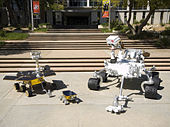 MSL mockup compared with the Mars Exploration Rover and Sojourner rover by the Jet Propulsion Laboratory on May 12, 2008
MSL mockup compared with the Mars Exploration Rover and Sojourner rover by the Jet Propulsion Laboratory on May 12, 2008
Opportunity was poised to enter Victoria Crater from its perch on the rim of Duck Bay on June 28, 2007,[12] but due to extensive dust storms, it was indefinitely delayed until the dust had cleared and power returned to safe levels.[13] Two months later, Spirit and Opportunity resumed driving after hunkering down during raging dust storms that limited solar power to a level that nearly caused the permanent failure of both rovers.[14]
On October 1, 2007,[15] both Spirit and Opportunity entered their fifth mission extension that extended operations into 2009,[16] allowing the rovers to have spent five years exploring the Martian surface, pending their continued survival.
On August 26, 2008, Opportunity began its three-day climb out of Victoria crater amidst concerns that power spikes, similar to those seen on Spirit before the failure of its right-front wheel, might prevent it from ever being able to leave the crater if a wheel failed. Project scientist Bruce Banerdt also said, "We've done everything we entered Victoria Crater to do and more." Opportunity will return to the plains in order to characterize Meridiani Planum's vast diversity of rocks—some of which may have been blasted out of craters such as Victoria. The rover had been exploring Victoria Crater since September 11, 2007.[17][18] As of January 2009, the two rovers had collectively sent back 250,000 images and traveled over 21 kilometers (13 mi).[19]
After driving about 3.2 kilometers (2.0 mi) since it left Victoria crater, Opportunity first saw the rim of Endeavour crater on March 7, 2009.[20][21] It passed the 10-mile mark (16 kilometers) along the way on sol 1897.[22] Meanwhile, at Gusev crater, Spirit was dug in deep into the Martian sand, much as Opportunity was at Purgatory Dune in 2005.[23]
On January 3 and January 24, 2010, Spirit and Opportunity marked six years on Mars, respectively.[24] On January 26, NASA announced that Spirit will be used as a stationary research platform after several months of unsuccessful attempts to free the rover from soft sand.[25]
NASA announced on March 24, 2010, that Opportunity, which has an estimated remaining drive distance of 12 km to Endeavour Crater, has traveled over 20 km since the start of its mission.[26] Each rover was designed with a mission driving distance goal of just 600 meters.[26] One week later, they announced that Spirit may have gone into hibernation for the Martian winter and might not wake up again for months.[27]
On September 8, 2010, it was announced that Opportunity had reached the halfway point of the 19-kilometer journey between Victoria crater and Endeavour crater.[28]
On May 24, 2011, NASA announced that it will cease attempts to contact Spirit, which has been stuck in a sand trap for two years. The last successful communication with the rover was on March 22, 2010. The final transmission to the rover was on May 25, 2011. [29]
Spacecraft design
 Delta II Heavy (7925H-9.5) lifting off from pad 17-B carrying MER-B
Delta II Heavy (7925H-9.5) lifting off from pad 17-B carrying MER-B
The Mars Exploration Rover was designed to be stowed in the nose of a Delta II rocket. Each spacecraft consists of several components:
- Rover: 185 kg (408 lb)
- Lander: 348 kg (767 lb)
- Backshell / Parachute: 209 kg (461 lb)
- Heat Shield: 78 kg (172 lb)
- Cruise Stage: 193 kg (425 lb)
- Propellant: 50 kg (110 lb)
- Instruments: 5 kg (11 lb)[30]
Total mass is 1,063 kg (2,343 lb).
Cruise stage
The cruise stage is the component of the spacecraft that is used for travel from Earth to Mars. It is very similar to the Mars Pathfinder in design and is approximately 2.65 meters (8.7 ft) in diameter and 1.6 m (5.2 ft) tall, including the entry vehicle (see below).
The primary structure is aluminium with an outer ring of ribs covered by the solar panels, which are about 2.65 m (8.7 ft) in diameter. Divided into five sections, the solar arrays can provide up to 600 watts of power near Earth and 300 W at Mars.
Heaters and multi-layer insulation keep the electronics "warm". A freon system removes heat from the flight computer and communications hardware inside the rover so they do not overheat. Cruise avionics systems allow the flight computer to interface with other electronics, such as the sun sensors, star scanner and heaters.
The star scanner (with a backup system) and sun sensor allowed the spacecraft to know its orientation in space by analyzing the position of the Sun and other stars in relation to itself. Sometimes the craft could be slightly off course; this was expected, given the 500 million kilometer (320 million mile) journey. Thus navigators planned up to six trajectory correction maneuvers, along with health checks.
To ensure the spacecraft arrived at Mars in the right place for its landing, two light-weight, aluminium-lined tanks carried about 31 kg (about 68 lb) of hydrazine propellant. Along with cruise guidance and control systems, the propellant allowed navigators to keep the spacecraft on course. Burns and pulse firings of the propellant allowed three types of maneuvers:
- An axial burn uses pairs of thrusters to change spacecraft velocity;
- A lateral burn uses two "thruster clusters" (four thrusters per cluster) to move the spacecraft "sideways" through seconds-long pulses;
- Pulse mode firing uses coupled thruster pairs for spacecraft precession maneuvers (turns).
Communication
The spacecraft used a high-frequency X band radio wavelength to communicate, which allowed for less power and smaller antennas than many older craft, which used S band.
Navigators sent commands through two antennas on the cruise stage: a cruise low-gain antenna mounted inside the inner ring, and a cruise medium-gain antenna in the outer ring. The low-gain antenna was used close to Earth. It is omni-directional, so the transmission power that reached Earth fell faster with increasing distance. As the craft moved closer to Mars, the Sun and Earth moved closer in the sky as viewed from the craft, so less energy reached Earth. The spacecraft then switched to the medium-gain antenna, which directed the same amount of transmission power into a tighter beam toward Earth.
During flight, the spacecraft was spin-stabilized with a spin rate of two revolutions per minute (rpm). Periodic updates kept antennas pointed toward Earth and solar panels toward the Sun.
Aeroshell
The aeroshell maintained a protective covering for the lander during the seven month voyage to Mars. Together with the lander and the rover, it constituted the "entry vehicle". Its main purpose was to protect the lander and the rover inside it from the intense heat of entry into the thin Martian atmosphere. It was based on the Mars Pathfinder and Mars Viking designs.
Parts
The aeroshell was made of two main parts: a heat shield and a backshell. The heat shield was flat and brownish, and protected the lander and rover during entry into the Martian atmosphere and acted as the first aerobrake for the spacecraft. The backshell was large, cone-shaped and painted white. It carried the parachute and several components used in later stages of entry, descent, and landing, including:
- A parachute (stowed at the top of the backshell);
- The backshell electronics and batteries that fire off pyrotechnic devices like separation nuts, rockets and the parachute mortar;
- A Litton LN-200 Inertial Measurement Unit (IMU), which monitors and reports the orientation of the backshell as it swings under the parachute;
- Three large solid rocket motors called RAD rockets (Rocket Assisted Descent), each providing about a ton of force (10 kilonewtons) for about 4 seconds;
- Three small solid rockets called TIRS (mounted so that they aim horizontally out the sides of the backshell) that provide a small horizontal kick to the backshell to help orient the backshell more vertically during the main RAD rocket burn.
Composition
Built by the Lockheed Martin Astronautics Co. in Denver, Colorado, the aeroshell is made of an aluminium honeycomb structure sandwiched between graphite-epoxy face sheets. The outside of the aeroshell is covered with a layer of phenolic honeycomb. This honeycomb is filled with an ablative material (also called an "ablator"), that dissipates heat generated by atmospheric friction.
The ablator itself is a unique blend of cork wood, binder and many tiny silica glass spheres. It was invented for the heat shields flown on the Viking Mars lander missions. A similar technology was used in the first US manned space missions Mercury, Gemini and Apollo. It was specially formulated to react chemically with the Martian atmosphere during entry and carry heat away, leaving a hot wake of gas behind the vehicle. The vehicle slowed from 19000 km/h (about 12000 mph) to about 1600 km/h (1000 mph) in about a minute, producing about 60 m/s² (6 g) of acceleration on the lander and rover.
The backshell and heat shield are made of the same materials, but the heat shield has a thicker, 1⁄2-inch (13 mm), layer of the ablator. Instead of being painted, the backshell was covered with a very thin aluminized PET film blanket to protect it from the cold of deep space. The blanket vaporized during entry into the Martian atmosphere.
Parachute
The parachute helped slow the spacecraft during entry, descent, and landing. It is located in the backshell.[31]
Design
The 2003 parachute design was part of a long-term Mars parachute technology development effort and is based on the designs and experience of the Viking and Pathfinder missions. The parachute for this mission is 40% larger than Pathfinder's because the largest load for the Mars Exploration Rover is 80 to 85 kilonewtons (kN) or 18,000 to 19,000 lbf (85 kN) when the parachute fully inflates. By comparison, Pathfinder's inflation loads were approximately 35 kN (about 8,000 lbf). The parachute was designed and constructed in South Windsor, Connecticut by Pioneer Aerospace, the company that also designed the parachute for the Stardust mission.[31]
Composition
The parachute is made of two durable, lightweight fabrics: polyester and nylon. A triple bridle made of Kevlar connects the parachute to the backshell.
The amount of space available on the spacecraft for the parachute is so small that the parachute had to be pressure-packed. Before launch, a team tightly folded the 48 suspension lines, three bridle lines, and the parachute. The parachute team loaded the parachute in a special structure that then applied a heavy weight to the parachute package several times. Before placing the parachute into the backshell, the parachute was heat set to sterilize it.[31]
Connected systems
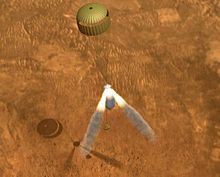 Descent is halted by retrorockets and lander is dropped 10m (30 ft) to the surface in this computer generated impression.
Descent is halted by retrorockets and lander is dropped 10m (30 ft) to the surface in this computer generated impression.
Zylon Bridles: After the parachute was deployed at an altitude of about 10 km (6.2 mi) above the surface, the heatshield was released using 6 separation nuts and push-off springs. The lander then separated from the backshell and "rappelled" down a metal tape on a centrifugal braking system built into one of the lander petals. The slow descent down the metal tape placed the lander in position at the end of another bridle (tether), made of a nearly 20 m (65 ft) long braided Zylon.[31]
Zylon is an advanced fiber material, similar to Kevlar, that is sewn in a webbing pattern (like shoelace material) to make it stronger. The Zylon bridle provides space for airbag deployment, distance from the solid rocket motor exhaust stream, and increased stability. The bridle incorporates an electrical harness that allows the firing of the solid rockets from the backshell as well as provides data from the backshell inertial measurement unit (which measures rate and tilt of the spacecraft) to the flight computer in the rover.[31]
Rocket assisted descent (RAD) motors: Because the atmospheric density of Mars is less than 1% of Earth's, the parachute alone could not slow down the Mars Exploration Rover enough to ensure a safe, low landing speed. The spacecraft descent was assisted by rockets that brought the spacecraft to a dead stop 10–15 m (30–50 ft) above the Martian surface.[31]
Radar altimeter unit: A radar altimeter unit was used to determine the distance to the Martian surface. The radar's antenna is mounted at one of the lower corners of the lander tetrahedron. When the radar measurement showed the lander was the correct distance above the surface, the Zylon bridle was cut, releasing the lander from the parachute and backshell so that it was free and clear for landing. The radar data also enabled the timing sequence on airbag inflation and backshell RAD rocket firing.[31]
Airbags
Airbags used in the Mars Exploration Rover mission are the same type that Mars Pathfinder used in 1997. They had to be strong enough to cushion the spacecraft if it landed on rocks or rough terrain and allow it to bounce across Mars' surface at freeway speeds after landing. The airbags had to be inflated seconds before touchdown and deflated once safely on the ground.
The airbags were made of Vectran, like those on Pathfinder. Vectran has almost twice the strength of other synthetic materials, such as Kevlar, and performs better in cold temperatures. Six 100 denier (10 mg/m) layers of Vectran protected one or two inner bladders of Vectran in 200 denier (20 mg/m). Using 100 denier (10 mg/m) leaves more fabric in the outer layers where it is needed, because there are more threads in the weave.
Each rover used four airbags with six lobes each, all of which were connected. Connection was important, since it helped abate some of the landing forces by keeping the bag system flexible and responsive to ground pressure. The airbags were not attached directly to the rover, but were held to it by ropes crisscrossing the bag structure. The ropes gave the bags shape, making inflation easier. While in flight, the bags were stowed along with three gas generators that are used for inflation.
Lander
The spacecraft lander is a protective shell that houses the rover, and together with the airbags, protects it from the forces of impact.
The lander is a tetrahedron shape, whose sides open like petals. It is strong and light, and made of beams and sheets. The beams consist of layers of graphite fiber woven into a fabric that is lighter than aluminium and more rigid than steel. Titanium fittings are glued and fitted onto the beams to allow it to be bolted together. The rover was held inside the lander by bolts and special nuts that were released after landing with small explosives.
Uprighting
After the lander stopped bouncing and rolling on the ground, it came to rest on the base of the tetrahedron or one of its sides. The sides then opened to make the base horizontal and the rover upright. The sides are connected to the base by hinges, each of which has a motor strong enough to lift the lander. The rover plus lander has a mass of about 533 kilograms (1,175 pounds). The rover alone weighs about 185 kg (408 lb). The gravity on Mars is about 38% of Earth's, so the motor does not need to be as powerful as it would on Earth.
The rover contains accelerometers to detect which way is down (toward the surface of Mars) by measuring the pull of gravity. The rover computer then commanded the correct lander petal to open to place the rover upright. Once the base petal was down and the rover was upright, the other two petals were opened.
The petals initially opened to an equally flat position, so all sides of the lander were straight and level. The petal motors are strong enough so that if two of the petals come to rest on rocks, the base with the rover would be held in place like a bridge above the ground. The base will hold at a level even with the height of the petals resting on rocks, making a straight flat surface throughout the length of the open, flattened lander. The flight team on Earth could then send commands to the rover to adjust the petals and create a safe path for the rover to drive off the lander and onto the Martian surface without dropping off a steep rock.
Moving the payload onto Mars
The moving of the rover off the lander is called the egress phase of the mission. The rover must avoid having its wheels caught in the airbag material or falling off a sharp incline. To help this, a retraction system on the petals slowly drags the airbags toward the lander before the petals open. Small ramps on the petals fan out to fill spaces between the petals. They cover uneven terrain, rock obstacles, and airbag material, and form a circular area from which the rover can drive off in more directions. They also lower the step that the rover must climb down. They are nicknamed "batwings", and are made of Vectran cloth.
About three hours were allotted to retract the airbags and deploy the lander petals.
Rover design
 Mars Exploration Rover (rear) vs. Sojourner rover (Courtesy NASA/JPL-Caltech)
Mars Exploration Rover (rear) vs. Sojourner rover (Courtesy NASA/JPL-Caltech)
The rovers are six-wheeled, solar-powered robots that stand 1.5 m (4.9 ft) high, 2.3 m (7.5 ft) wide and 1.6 m (5.2 ft) long. They weigh 180 kg (400 lb), 35 kg (80 lb) of which is the wheel and suspension system.[32]
Drive system
Each rover has six wheels mounted on a rocker-bogie suspension system that ensures wheels remain on the ground while driving over rough terrain. The design reduces the range of motion of the rover body by half, and allows the rover to go over obstacles or through holes that are more than a wheel diameter (250 millimetres (9.8 in)) in size. Each wheel also has cleats, providing grip for climbing in soft sand and scrambling over rocks.
Each wheel has its own motor. The two front and two rear wheels each have individual steering motors. This allows the vehicle to turn in place, a full revolution, and to swerve and curve, making arching turns. The rover is designed to withstand a tilt of 45 degrees in any direction without overturning. However, the rover is programmed through its "fault protection limits" in its hazard avoidance software to avoid exceeding tilts of 30 degrees.
Each rover can spin one of its front wheels in place to grind deep into the terrain. It is to remain motionless while the digging wheel is spinning. The rovers have a top speed on flat hard ground of 50 mm/s (2 in/s). The average speed is 10 mm/s, because its hazard avoidance software causes it to stop every 10 seconds for 20 seconds to observe and understand the terrain into which it has driven.
Power and electronic systems
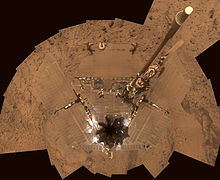 Circular projection showing MER-A Spirit's solar panels covered in dust in October 2007 on Mars. Unexpected cleaning events have periodically increased power.
Circular projection showing MER-A Spirit's solar panels covered in dust in October 2007 on Mars. Unexpected cleaning events have periodically increased power.
When fully illuminated, the rover triplejunction[33] solar arrays generate about 140 watts for up to four hours per Martian day (sol). The rover needs about 100 watts to drive. Its power system includes two rechargeable lithium ion batteries weighing 7.15 kg (16 pounds) each, that provide energy when the sun is not shining, especially at night. Over time, the batteries will degrade and will not be able to recharge to full capacity.
For comparison, the future Mars Science Laboratory's power system is composed of a Multi-Mission Radioisotope Thermoelectric Generator (MMRTG) produced by Boeing.[34] The MMRTG is designed to provide 125W of electrical power at the start of the mission, falling to 100W after 14 years of service.[35] It will be used to power the MSL's many systems and instruments. Solar panels were also considered for the MSL, but RTGs provide constant power, regardless of the time of day, and thus the versatility to work in dark environments and high latitudes where solar energy is not readily available. The MSL will generate 2.5 kilowatt hours per day, compared to the Mars Exploration Rovers, which can generate about 0.6 kilowatt hours per day.[36]
It was thought that by the end of the 90-sol mission, the capability of the solar arrays to generate power would likely be reduced to about 50 watts. This was due to anticipated dust coverage on the solar arrays, and the change in season. Over three Earth years later, however, the rovers' power supplies hovered between 300 watt-hours and 900 watt-hours per day, depending on dust coverage. Cleaning events (dust removal by wind) have occurred more often than NASA expected, keeping the arrays relatively free of dust and extending the life of the mission. During a 2007 global dust storm on Mars, both rovers experienced some of the lowest power of the mission; Opportunity dipped to 128 watt-hours. In November 2008, Spirit had overtaken this low-energy record with a production of 89 watt-hours, due to dust storms in the region of Gusev crater.[37]
The rovers run a VxWorks embedded operating system on a radiation-hardened 20 MHz RAD6000 CPU with 128 MB of DRAM with error detection and correction and 3 MB of EEPROM. Each rover also has 256 MB of flash memory. To survive during the various mission phases, the rover's vital instruments must stay within a temperature of −40 °C to +40 °C (−40 °F to 104 °F). At night, the rovers are heated by eight radioisotope heater units (RHU), which each continuously generate 1 W of thermal energy from the decay of radioisotopes, along with electrical heaters that operate only when necessary. A sputtered gold film and a layer of silica aerogel are used for insulation.
Communication
The rover has a low-gain and a high-gain antenna. The low-gain antenna is omnidirectional, and transmits data at a low rate to Deep Space Network (DSN) antennas on Earth. The high-gain antenna is directional and steerable, and can transmit data to Earth at a higher rate. The rovers also use the low-gain antennas and its Electra software-defined radio to communicate with spacecraft orbiting Mars, the Mars Odyssey and (before its failure) the Mars Global Surveyor (using its Mars Relay antenna and Mars Orbiter Camera's memory buffer to transfer more than 7.6 terabits of data).[38] The orbiters relay data from and to Earth; most data to Earth is relayed through Odyssey. The orbiters are closer to the rovers than the antennas on Earth, and have a view of Earth for much longer than the rovers. The orbiters communicate with the rovers using UHF antennas, which have shorter range than the low and high-gain antennas. One UHF antenna is on the rover, and one is on a petal of the lander to aid in gaining information during the critical landing event.
Each rover has a total of 9 cameras, which produce 1024-pixel by 1024-pixel images at 12 bits per pixel,[39] but most navigation camera images and image thumbnails are truncated to 8 bits per pixel to conserve memory and transmission time. All images are then compressed using ICER before being stored and sent to Earth. Navigation, thumbnail, and many other image types are compressed to approximately 0.8 to 1.1 bits/pixel. Lower bit rates (less than 0.5 bit/pixel) are used for certain wavelengths of multi-color panoramic images.
ICER is based on wavelets, and was designed specifically for deep-space applications. It produces progressive compression, both lossless and lossy, and incorporates an error-containment scheme to limit the effects of data loss on the deep-space channel. It outperforms the lossy JPEG image compressor and the lossless Rice compressor used by the Mars Pathfinder mission.
Scientific instrumentation
The rover has various instruments. Three are mounted on one assembly:
- Panoramic Camera (Pancam), for determining the texture, color, mineralogy, and structure of the local terrain.
- Navigation Camera (Navcam), that has higher field of view but lower resolution and is monochromatic, for navigation and driving.
- A mirror for the Miniature Thermal Emission Spectrometer (Mini-TES), which identifies promising rocks and soils for closer examination, and determines the processes that formed them. It was built by Arizona State University.
The cameras are mounted 1.5 meters high on the Pancam Mast Assembly. One motor turns the assembly horizontally a whole revolution. Another points the cameras vertically, at most straight up or down. A third motor points the Mini-TES, up to 30° above the horizon and 50° below. The assembly was built by Ball Aerospace & Technologies Corp., Boulder, Colorado, as was the High-Gain Antenna Gimbal (HGAG).
Four monochromatic hazard cameras (Hazcams) are mounted on the rover's body, two in front and two behind.
The instrument deployment device (IDD), also called the rover arm, holds the following:
- Mössbauer spectrometer (MB) MIMOS II, developed by Dr. Göstar Klingelhöfer at the Johannes Gutenberg University in Mainz, Germany, is used for close-up investigations of the mineralogy of iron-bearing rocks and soils.[40][41]
- Alpha Particle X-Ray Spectrometer (APXS), developed by the Max Planck Institute for Chemistry in Mainz, Germany, is used for close-up analysis of the abundances of elements that make up rocks and soils.[42] Universities involved in developing the APXS include the University of Guelph, University of California, and Cornell University
- Magnets, for collecting magnetic dust particles, developed by Jens Martin Knudsen's group at the Niels Bohr Institute, Copenhagen. The particles are analyzed by the Mössbauer Spectrometer and X-ray Spectrometer to help determine the ratio of magnetic particles to non-magnetic particles and the composition of magnetic minerals in airborne dust and rocks that have been ground by the Rock Abrasion Tool. There are also magnets on the front of the rover, which are studied extensively by the Mössbauer spectrometer.
- Microscopic Imager (MI) for obtaining close-up, high-resolution images of rocks and soils. Development was led by Ken Herkenhoff's team at the USGS Astrogeology Research Program.
- Rock Abrasion Tool (RAT), developed by Honeybee Robotics, for removing dusty and weathered rock surfaces and exposing fresh material for examination by instruments on-board.
The robotic arm is able to place instruments directly up against rock and soil targets of interest.
Naming of Spirit and Opportunity
The Spirit and Opportunity rovers were named through a student essay competition. The winning entry was by Sofi Collis, a third-grade Russian-American student from Arizona.
I used to live in an orphanage. It was dark and cold and lonely. At night, I looked up at the sparkly sky and felt better. I dreamed I could fly there. In America, I can make all my dreams come true. Thank you for the 'Spirit' and the 'Opportunity.'
— Sofi Collis, age 9Prior to this, during the development and building of the rovers, they were known as MER-1 (Opportunity) and MER-2 (Spirit). Internally, NASA also uses the mission designations MER-A (Spirit) and MER-B (Opportunity) based on the order of landing on Mars (Spirit first then Opportunity).
Test rovers
The Jet Propulsion Laboratory maintains a pair of rovers at its location in Pasadena for testing and modeling of situations on Mars. One test rover, weighing approximately 180 kilograms (400 lb), is fully instrumented and nearly identical to Spirit and Opportunity. Another test version is identical in size and drive characteristics but does not include all instruments. It weighs in at 80 kilograms (180 lb), much closer to the weight of Spirit and Opportunity in the reduced gravity of Mars. These rovers were used in 2009 for a simulation of the incident in which Spirit became trapped in soft soil.[43]
SAP
The NASA team uses a software application called SAP to view images collected from the rover, and to plan its daily activities. There is a version available to the public called Maestro.[citation needed]
Related
- Spirit rover (MER-A) · Opportunity rover (MER-B) · Scientific information from the Mars Exploration Rover mission · Cleaning event
- List of surface features of Mars seen by the Spirit rover · List of surface features of Mars seen by the Opportunity rover
- 37452 Spirit · 39382 Opportunity
- Instruments
- APXS · MIMOS II · Mini-TES · Rock Abrasion Tool (RAT) · Hazcam · Pancam · Navcam
- Communication
- Low gain antenna · High gain antenna · 2001 Mars Odyssey · Mars Reconnaissance Orbiter · Deep Space Network · Goldstone DSCC · X-Band
- Other Systems
- Delta II Heavy · Maestro · VxWorks · RAD6000 · Radioisotope heater unit · Rocker-bogie · Multijunction photovoltaic cell · Lithium ion battery
- Supporting Institutions
- NASA · JPL · Boeing IDS · Cornell University · Deep Space Network · Arizona State University · The Aerospace Corporation · Ball Aerospace · Johannes Gutenberg University · Max Planck Institute for Chemistry · Niels Bohr Institute · USGS Astrogeology Research Program · Honeybee Robotics
See also
- Opportunity rover (MER-B)
- Spirit rover (MER-A)
- Exploration of Mars
- Space exploration
- Atmospheric reentry
- Syd Lieberman (Official storyteller of the Mars Exploration Mission)
- Lunokhod programme (Lunar rovers)
- Mars Science Laboratory (Next planned NASA Mars rover)
Glossary
- APXS: Alpha Particle X-Ray Spectrometer
- DSCC: Deep Space Communications Center
- DSN: Deep Space Network
- DTSTART: Dead Time Start
- ERT: Earth-received time, UTC of an event
- FSW: flight software
- HGA: High Gain Antenna
- LGA: Low Gain Antenna
- MER: Mars Exploration Rover
- MSL: Mars Science Laboratory
- Mini-TES:Miniature Thermal Emission Spectrometer
- NASA: National Aeronautics and Space Administration (USA)
- Navcam: Navigation camera
- Pancam: Panoramic camera
- RAT: Rock Abrasion Tool
- RCS: Reaction Control System
References
- Portions of this article are adopted from NASA/JPL MER article.
- Additional information was adapted from the MER homepage
- ^ "Mars Exploration Rover Mission Overview". NASA. http://marsrovers.nasa.gov/overview.
- ^ a b c "NASA extends Mars rovers' mission". MSNBC. 2007-10-16. http://www.msnbc.msn.com/id/21327647/. Retrieved 2009-04-05.
- ^ Mars Exploration Rover Mission: Press Releases
- ^ "Mars Exploration Rover Status Report: Rovers Resume Driving". nasa.gov. http://www.nasa.gov/mission_pages/mer/mer-20070824.html. Retrieved 2007-09-03.
- ^ Henry Fountain (May 25, 2009). "Crater was Shaped by Wind and Water, Mars Rover Data Shows". New York Times. http://www.nytimes.com/2009/05/26/science/26obmars.html. Retrieved May 26, 2009.
- ^ "Now a Stationary Research Platform, NASA's Mars Rover Spirit Starts a New Chapter in Red Planet Scientific Studies". http://marsrover.nasa.gov/newsroom/pressreleases/20100126a.html. Retrieved 2010-01-28.
- ^ "NASA Concludes Attempts to Contact Mars Rover Spirit". NASA. http://www.jpl.nasa.gov/news/news.cfm?release=2011-156&cid=release_2011-156. Retrieved 25 May 2011.
- ^ The scientific objectives of the Mars Exploration Rover
- ^ "NASA Mars Rover Arrives at Dramatic Vista on Red Planet". nasa.gov. http://www.nasa.gov/mission_pages/mer/mer-20060927.html. Retrieved 2006-09-28.
- ^ "Mars rover, Global Surveyor, Odyssey missions extended". http://spaceflightnow.com/news/n0609/26rovers/. Retrieved 2006-09-27.
- ^ "Opportunity Passes 10-Kilometer Mark". nasa.gov. http://www.nasa.gov/mission_pages/mer/images/opp-20070207.html. Retrieved 2007-02-08.
- ^ "NASA Mars Rover Ready For Descent Into Crater". jpl.nasa.gov. http://marsrovers.jpl.nasa.gov/newsroom/pressreleases/20070628a.html. Retrieved 2007-07-15.
- ^ "Opportunity Waiting for Dust to Settle". jpl.nasa.gov. http://marsrovers.jpl.nasa.gov/mission/status_opportunityAll.html#sol1220. Retrieved 2007-07-15.
- ^ "Mars Exploration Rover Status Report: Rovers Resume Driving". NASA. http://www.nasa.gov/mission_pages/mer/mer-20070824.html. Retrieved 2007-08-30.
- ^ "Hardy Rover Continues to Celebrate Milestones". NASA. http://marsrovers.jpl.nasa.gov/mission/status_spiritAll.html#sol1337. Retrieved 2007-10-16.
- ^ "NASA Extends Mars Rover Mission a Fifth Time". NASA. http://www.space.com/missionlaunches/071015-marsrover-extendedmission.html. Retrieved 2007-10-16.
- ^ "NASA's Mars Rover Opportunity Climbing out of Victoria Crater". jpl.nasa.gov. http://www.jpl.nasa.gov/news/news.cfm?release=2008-166. Retrieved 2008-08-27.
- ^ "NASA Mars Rover Opportunity Ascends to Level Ground". jpl.nasa.gov. http://marsrovers.jpl.nasa.gov/newsroom/pressreleases/20080829a.html. Retrieved 2008-08-29.
- ^ "NASA's rovers mark five years on Red Planet". CNN. 2009-01-03. http://www.cnn.com/2009/TECH/01/03/mars.rovers.five.years/index.html. Retrieved 2009-01-03.
- ^ "One Mars Rover Sees A Distant Goal; The Other Takes A New Route". NASA/JPL. 2009-03-18. http://marsrovers.jpl.nasa.gov/newsroom/pressreleases/20090318a.html. Retrieved 2009-03-20.
- ^ "One Mars Rover Sees A Distant Goal; The Other Takes A New Route". NASA/JPL. 2009-03-18. http://marsrovers.jpl.nasa.gov/gallery/press/opportunity/20090318a.html. Retrieved 2009-03-20.
- ^ "Opportunity Rover Passes 10-Mile Mark on Mars". Space.com. 2009-05-26. http://www.space.com/missionlaunches/090526-opp-10-miles.html. Retrieved 2009-05-27.
- ^ "Spirit Stuck In 'Insidious Invisible Rover Trap' on Mars". Space.com. 2009-05-21. http://www.space.com/missionlaunches/090521-spirit-stuck.html. Retrieved 2009-05-27.
- ^ http://marsrovers.jpl.nasa.gov/newsroom/pressreleases/20091231a.html
- ^ "Now a Stationary Research Platform, NASA's Mars Rover Spirit Starts a New Chapter in Red Planet Scientific Studies". NASA. 2010-01-26. http://www.nasa.gov/mission_pages/mer/news/mer20100126.html. Retrieved 2010-01-29.
- ^ a b "Opportunity Surpasses 20 Kilometers of Total Driving". NASA. 2010-03-24. http://marsrover.nasa.gov/newsroom/pressreleases/20100324b.html. Retrieved 2010-04-18.
- ^ "Spirit May Have Begun Months-Long Hibernation". NASA. 2010-03-31. http://marsrover.nasa.gov/newsroom/pressreleases/20100331a.html. Retrieved 2010-04-18.
- ^ "Opportunity Rover Reaches Halfway Point of Long Trek". NASA/JPL. 2010-09-08. http://marsrovers.jpl.nasa.gov/newsroom/pressreleases/20100908a.html. Retrieved 2010-10-12.
- ^ "NASA Concludes Attempts to Contact Mars Rover Spirit". NASA/JPL. 2011-05-24. http://www.nasa.gov/mission_pages/mer/news/mer20110524.html. Retrieved 2011-05-25.
- ^ "Spirit and Opportunity: Wheels on Mars". SpringerLink. http://www.springerlink.com/content/p5280r1m6170325m/fulltext.pdf?page=1. Retrieved 2010-07-22.
- ^ a b c d e f g "Mars Exploration Rover Mission: The Mission". nasa.gov. http://marsrovers.nasa.gov/mission/spacecraft_edl_parachute.html. Retrieved September 2007.
- ^ "MER Technical Data". http://hobbiton.thisside.net/rovermanual/. Retrieved July 15, 2007.
- ^ D. Crisp, , a, A. Pathareb and R. C. Ewell (2004). "The performance of gallium arsenide/germanium solar cells at the Martian surface". Progress in Photovoltaics Research and Applications 54 (2): 83–101. doi:10.1016/S0094-5765(02)00287-4.
- ^ "Technologies of Broad Benefit: Power". Archived from the original on 2008-06-14. http://web.archive.org/web/20080614071650/http://marsprogram.jpl.nasa.gov/msl/technology/tech_power.html. Retrieved 2008-09-20.
- ^ http://pdf.aiaa.org/preview/CDReadyMIECEC06_1309/PV2006_4187.pdf
- ^ Watson, Traci (2008-04-14). "Troubles parallel ambitions in NASA Mars project". USA Today. http://www.usatoday.com/tech/science/space/2008-04-13-mars_N.htm. Retrieved 2009-05-27.
- ^ "Mars dust storms threaten rovers". BBC News. July 21, 2007. http://news.bbc.co.uk/2/hi/science/nature/6909656.stm. Retrieved 2007-07-22.
- ^ http://www.marsjournal.org/contents/2010/0001/files/malin_mars_2010_0001.pdf
- ^ [1][dead link]
- ^ Klingelhöfer G., Bernhardt B., Foh J., Bonnes U., Rodionov D., De Souza P. A., Schroder C., Gellert R., Kane S., Gutlich P., Kankeleit E. (2002). "The miniaturized Mössbauer spectrometer MIMOS II for extraterrestrial and outdoor terrestrial applications: A status report". Hyperfine Interactions 144: 371–379. Bibcode 2002HyInt.144..371K. doi:10.1023/A:1025444209059.
- ^ Klingelhoefer et al. (2007). "THE MINIATURISED MOESSBAUER SPECTROMETER MIMOS II: APPLICATION FOR THE “PHOBOS-GRUNT” MISSION.". http://www.lpi.usra.edu/meetings/phobosdeimos2007/pdf/7038.pdf.
- ^ R. Rieder, R. Gellert, J. Brückner, G. Klingelhöfer, G. Dreibus, A. Yen, S. W. Squyres (2003). "The new Athena alpha particle X-ray spectrometer for the Mars Exploration Rovers". J. Geophysical Research 108: 8066. Bibcode 2003JGRE..108.8066R. doi:10.1029/2003JE002150.
- ^ "Mars and Earth Activities Aim to Get Spirit Rolling Again". May 18, 2009. http://www.jpl.nasa.gov/news/news.cfm?release=2009-087. Retrieved 22 January 2010.
Further reading
-
This list is incomplete; you can help by expanding it.
- Roving Mars: Spirit, Opportunity, and the Exploration of the Red Planet by Steve Squyres (published August 2005; ISBN 1-4013-0149-5)
- Postcards from Mars: The First Photographer on the Red Planet by Jim Bell (published November 2006; ISBN 0-525-94985-2)
- Technical papers by JPL Robotics Engineers
- Interview: The driver behind NASA's Mars Rovers from Australian PC World
External links
- NASA JPL's MER website
- Spirit Mission Profile
- Opportunity Mission Profile
- Mars Exploration Rover project, NASA/JPL document NSS ISDC 2001 27 May 2001
- Science, 6 August 2004 - Scientific papers from the first phase of the Spirit mission
- Mars Rover Manual: Centralized resource for all publicly released rover technical details
- MER Analysts Notebook (access to the MER scientific data set)
- Scientific American Magazine (March 2004 Issue) The Spirit of Exploration
- Li2-Rover
- Official PanCam True Color Images Gallery
- Rover image gallery
- Nonofficial Daily PanCam Color Image Gallery
United States Mars Exploration Rover program General Mars Exploration Rover (MER) · Spirit rover (MER-A) · Opportunity rover (MER-B) · Scientific information from the Mars Exploration Rover mission · Cleaning event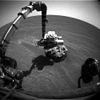
Spirit rover (MER-A) Opportunity rover (MER-B) Instruments Related Other Spacecraft missions to Mars Flybys 
Orbiters Mariner 9 · Mars 2 · 3 · 5 · Viking 1 · 2 · Phobos 2 · Mars Global Surveyor · 2001 Mars Odyssey · Mars Express · Mars Reconnaissance Orbiter · Fobos-Grunt · Yinghuo-1
Landers Rovers Sojourner · Mars Exploration Rovers (Spirit · Opportunity)
Planned missions Mars Science Laboratory (2011) · MetNet · MAVEN (2013) ·
ExoMars static lander and rover · ExoMars Trace Gas Orbiter (2016) · Northern LightUnplanned missions Related topics Exploration · Colonization · Failed Mars missions · Mars Scout Program
Bold italics indicate active missionsNASA planetary exploration programs Active Explorer · Small Explorer · Voyager · Discovery · New Frontiers · Flagship · Mars Exploration Rover
Completed Pioneer · Mariner · Lunar Orbiter · Ranger · Surveyor · Apollo · Viking · Planetary Observer · Mariner Mark II · MESUR · Mars Surveyor '98 · Mars Scout
Cancelled Categories:- Mars Exploration Rover
- Mars missions
- Winners of the Sir Arthur Clarke Award
- Planetary rovers
Wikimedia Foundation. 2010.

